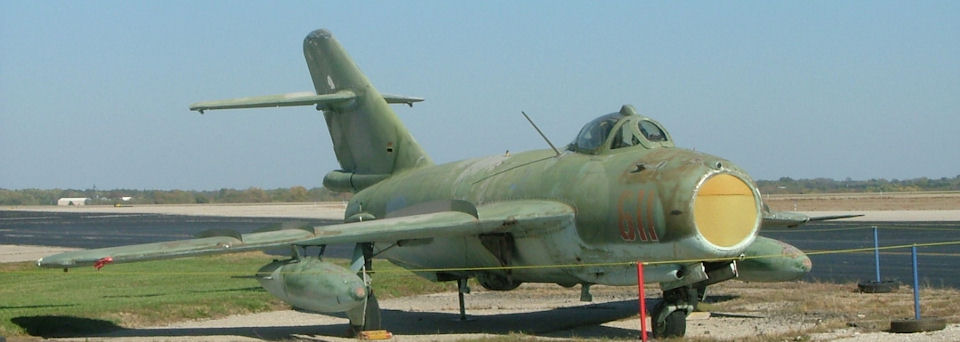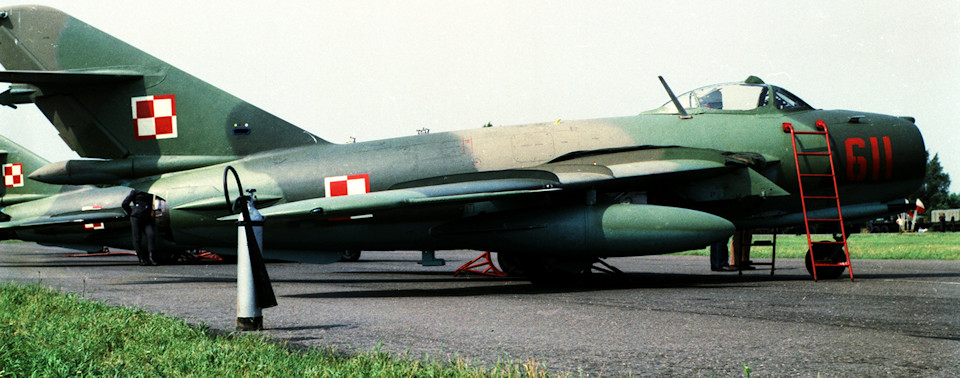This jet fighter is a Lim-6R, a Polish-built version of the Soviet Mikoyan-Gurevich
MiG-17 that was given the NATO (North Atlantic Treaty Organization) code
name Fresco. The Lim-6R was a photoreconnaissance aircraft that could
also be used as a fighter-bomber. Its tactical number, Red 611 (Polish Air Force markings 1J 06-11 )refers
to this aircraft.
The
MiG-17 was an upgraded and improved version of the Korean War era Soviet
MiG-15.
It was designed
in 1949 and first flown in 1950. The type
entered service in 1952 eventually replacing the MiG-15 as the Soviet’s
main fighter. Although the Fresco was not supersonic in level flight
it could break the sound barrier in a dive. The early MiG-17s had improved
versions of the MiG-15’s Klimov VK-1 turbojet. The greatly redesigned
VK-1F had an afterburner requiring a longer fuselage to accommodate the
afterburner section. The tail was changed and another fence was added
on each wing to improve the stability of the aircraft at high speeds.
The MiG-17's wing has two different sweep angles on the leading edge.
The resulting bend in the middle of the wing led to it being referred
to as a "sickle wing". The change in wing angle may not be
noticed until you sight along the leading edge of the wing; then the
bend is quite obvious. The appearance of the MiG-17 was so similar to
the MiG-15 that Western military personnel initially thought the MiG-17
another model of the MiG-15. Some 8,000 MiG-17s were manufactured between
1952 and 1958 and they were in service in the Warsaw Pact Air Forces
into the 1990s. Over 30 countries flew the various MiG-17 types. The
North Vietnamese Air Force flew MiG-17s in combat against US and allied
aircraft during the Vietnam War.
Polish
production of the MiG-17 took place at the WSK-Mielec factory in southeastern
Poland
beginning in November, 1956 with the Lim-5, then the Lim-6,
with variations of each type. Work on the last major production model,
the Lim-6bis variant, began in 1963 and lasted until 1964. This version
reverted to an original MiG-17F wing design and added an underwing pylon
on each inboard wing panel. A few of the Lim-6bis, including Red 611,
were modified for reconnaissance by addition of an AFA-39 camera pod.
This pod is on the lower right side of the aircraft’s mid-fuselage.
The
Lim-6bis and Lim-6R used a drogue parachute first seen on the basic
Lim-6. The bullet-shaped
housing for the parachute is located at the
base of the rudder and is found only on Polish-built MIG-17s. Poland
was the last country to build the MiG-17 design anywhere in the world,
since Soviet and Chinese production ended in the late 1950's.
Red
611 was manaufactured in late 1963 or early 1964 as a Lim-5, converted to a Lim-6R (reconnaissance) version and returned to Unit 21 SPLR at Sochaczew in late 1964 - February 1965. Our aircraft 1J 06-11 probably continued in active
use by
the Polish Air Force until 1991-1992 when Poland retired
their Lim-6 variants. The canopy is so small the pilot wore a leather
helmet rather than a modern hard helmet. Pilots often wore leather jackets,
too, making them
look more like World War II pilots than modern era jet fighter pilots.
The cockpit is also quite small. The gun sight takes up most of the
space
in the front of the canopy, restricting the pilot's view. In addition,
a rocket control panel was added to the cockpit when the plane was equipped
with rocket pods. Even in the Polish planes, most of the cockpit instruments
are written in Russian Cyrillic.
TECHNICAL
NOTES: |
Lim-6R/MiG-17F
Fresco C
|
Original Manufacturer: |
Mikoyan-Gurevich
|
Crew: |
Pilot
|
Primary
Use: |
Photoreconnaissance fighter-bomber
|
Engines: |
Klimov VK-1F turbojet with afterburner 7,452 lb
(3,383kg) static
thrust
|
Maximum speed: |
711 mph (1,142km/h) @10,000 ft (3,048m)
|
Cruising speed: |
|
Max Takeoff: |
13,352 lb (6,056kg)
|
Range: |
670 miles (1078 km) without additional tanks or 1,035 miles (1,666km) with wing tanks |
Service ceiling: |
54,460 ft (16,599m)
|
Wingspan: |
31 ft 7 in (9.63m)
|
Length: |
37 ft 3 in (11.35m)
|
Height: |
12 ft
6 in (3.81m)
|
Wing Area: |
243.2 sq ft (22.59sq m)
|
Weight (empty): |
8,646 lb (3,922kg)
|
Max.
Weight: |
11,803 lb (5,354kg)
|
Armament: |
One 37mm cannon, two 23mm cannon. Can carry up to 1,102 lb
(500kg)
of bombs or wing tanks.
|
Serial number: |
1J 06-11 |




